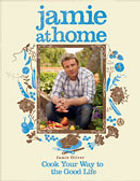- Healthy recipes
- Healthy snacks
- Healthy lunches
- Healthy chicken recipes
- Healthy fish recipes
- Healthy vegetarian recipes
- Main Ingredient
- Chicken
- Pasta
- Vegetables
- Fish
- Beef
- Eggs
- View more…
- Special Diets
- Vegan
- Vegetarian ideas
- Gluten-free
- Dairy-free
- Budget recipes
- One-pan recipes
- Meals for one
- Breakfast
- Desserts
- Quick fixes
- View more…
- Baking recipes
- Cakes
- Biscuit recipes
- Gluten-free bakes
- View more…
- Family recipes
- Money saving recipes
- Cooking with kids
- School night suppers
- Batch cooking
- View more…
- Special occasions
- Dinner party recipes
- Sunday roast recipes
- Dinner recipes for two
- View more…
- 5 Ingredients Mediterranean
- ONE
- Jamie’s Keep Cooking Family Favourites
- 7 Ways
- Veg
- View more…
- Nutrition
- What foods are good for gut health?
- Healthy eating tips
- Special diets guidance
- All about sugar
- Learn about portion size
- View more
- Features
- Cheap eats
- Healthy meals
- Air-fryer recipes
- Family cooking
- Quick fixes
- View more
- How to’s
- How to cook with frozen veg
- How to make the most of your oven
- How to make meals veggie or vegan
- View more
- More Jamie Oliver
- YesChef x Jamie Oliver
- Cookbook Club
- Jamie Oliver Group website
- Jamie Oliver Cookery School
- Ministry of Food
- Vegepedia
Pizza dough
For beautifully crispy pizzas
- Dairy-freedf
- Veganvg
- Vegetarianv

For beautifully crispy pizzas
- Dairy-freedf
- Veganvg
- Vegetarianv
“Once you've tried this easy pizza dough recipe, you'll never look back (trust me) ”
Makes 8 medium-sized thin bases
Cooks In20 minutes plus proving time
DifficultyNot too tricky
Jamie at HomeBaking
Nutrition per serving
-
Calories 490 25%
-
Fat 7.7g 11%
-
Saturates 1.1g 6%
-
Sugars 3.7g 4%
-
Salt 0.5g 8%
-
Protein 15g 30%
-
Carbs 96.1g 37%
-
Fibre 3.9g -
Of an adult's reference intake
Tap For Method
Ingredients
- 1 kg white bread flour or Tipo '00' flour , or 800g strong white bread flour or Tipo '00' flour, plus 200g finely ground semolina flour
- 1 teaspoon fine sea salt
- 2 x 7 g dried yeast sachets
- 1 tablespoon golden caster sugar
- 4 tablespoons extra virgin olive oil
Tap For Method
The cost per serving below is generated by Whisk.com and is based on costs in individual supermarkets. For more information about how we calculate costs per serving read our FAQS
Tap For Ingredients
Method
- Sieve the flour/s and salt on to a clean work surface and make a well in the middle.
- In a jug, mix the yeast, sugar and oil into 650ml of lukewarm water and leave for a few minutes, then pour into the well.
- Using a fork, bring the flour in gradually from the sides and swirl it into the liquid. Keep mixing, drawing larger amounts of flour in, and when it all starts to come together, work the rest of the flour in with your clean, flour-dusted hands. Knead until you have a smooth, springy dough.
- Place the ball of dough in a large flour-dusted bowl and flour the top of it. Cover the bowl with a damp cloth and place in a warm room for about an hour until the dough has doubled in size.
- Now remove the dough to a flour-dusted surface and knead it around a bit to push the air out with your hands – this is called knocking back the dough. You can either use it immediately, or keep it, wrapped in clingfilm, in the fridge (or freezer) until required.
- If using straight away, divide the dough up into as many little balls as you want to make pizzas – this amount of dough is enough to make about six to eight medium pizzas.
- Timing-wise, it’s a good idea to roll the pizzas out about 15 to 20 minutes before you want to cook them. Don’t roll them out and leave them hanging around for a few hours, though – if you are working in advance like this it’s better to leave your dough, covered with clingfilm, in the fridge. However, if you want to get them rolled out so there’s one less thing to do when your guests are round, simply roll the dough out into rough circles, about 0.5cm thick, and place them on slightly larger pieces of olive-oil-rubbed and flour-dusted tin foil. You can then stack the pizzas, cover them with clingfilm, and pop them into the fridge.
Tips
This dough is best made with Italian Tipo ‘00’ flour, which is finer ground than normal flour, and it will give your dough an incredible super-smooth texture. Look for it in Italian delis and good supermarkets. If using white bread flour instead, make sure it’s a strong one that’s high in gluten, as this will transform into a lovely, elastic dough, which is what you want. Mix in some semolina flour for a bit of colour and flavour, if you like.
Related features
Budget-friendly barbecue recipes
Beautiful baking recipes for Easter
Homemade vegan Easter eggs
Related video
How to make perfect pizza: Gennaro Contaldo
© 2024 Jamie Oliver Enterprises Limited
- Terms of Use
- Privacy Policy
- Cookies
- Jamie Oliver Group
- Contact
- Sitemap
© 2024 Jamie Oliver Enterprises Limited
